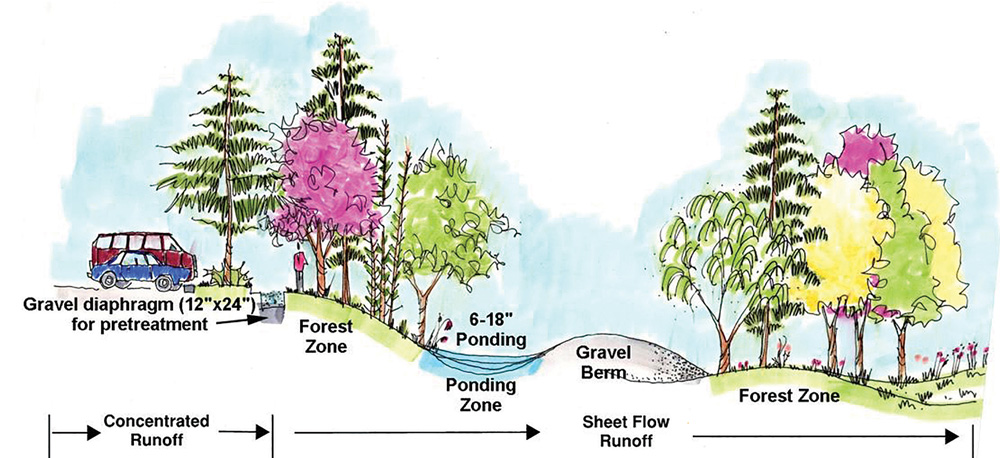
Protecting our environment, one stormwater practice at a time.
Filter Strips and Sheet Flow Practices
Overview
Filter strips are vegetated areas that treat sheet flow from adjacent impervious areas. There are two types of filter strips: vegetated filter strips and conserved open space. Vegetated filter strips are planted areas that may include turf grass, meadows or small forest plantings. Conserved open space preserves undisturbed areas that are usually hydrologically connected to a protected stream buffer, wetland buffer, floodplain, resource protection area or other protected area. Stormwater runoff must enter these practices as sheet flow, which is runoff that flows evenly across a surface.
Sheet flow techniques may be used in combination with rooftop disconnections, filter strips and other Best Management Practices (BMPs) to form a treatment train. Rooftop runoff is traditionally collected in gutters and piped directly to streets, storm drains and streams. Rooftop disconnection directs stormwater to a pervious surface or alternative treatment facility.
How Filter Strips and Sheet Flow Practices Work

Illustration courtesy of Matt Arnn, USDA Forest Service
Precipitation that falls on an impervious surface, such as a rooftop or parking lot, cannot infiltrate and usually becomes a faster-flowing, concentrated stream. This type of runoff causes erosion which releases and transports pollutants. Sheet flow practices are design techniques that work to spread out stormwater runoff allowing for enhanced infiltration and reduced pollutant release. To create sheet flow, devices such as engineered level spreaders, gravel diaphragms or permeable berms are used. These devices fill and release the water evenly as sheet flow to a filter strip or other BMP. Filter strips treat sheet flow by slowing runoff velocity, filtering sediment and other pollutants and providing infiltration into underlying soils.

Rooftop disconnections direct downspouts into open space. The simplest method is to cut a downspout and redirect it horizontally onto a splash pad to a pervious area. On smaller residential lots roof top disconnections may be directed to alternative runoff reduction practices such as cisterns, bioretention or infiltration practices and soil compost amendments.

How to Maintain a Filter Strips and Sheet Flow Practices
- Remove any accumulated sand and sediment deposits from filter strip, in front of level spreader, gravel diaphragm and constructed berm
- Maintain at least 90 percent vegetative cover in filter strip
- Vegetated filter strips that consist of grass/turf cover should be mowed at least twice a year to prevent woody growth
- Inspect filter strip for erosion and repair as needed
FairFacts
- Resource Protection Areas (RPAs) are corridors of environmentally sensitive land that lie alongside or near the shorelines of perennial streams and rivers. To obtain a map of a RPA visit the county’s Digital Map Viewer at https://www.fairfaxcounty.gov/gisapps/DMV/Default.aspx and select the map type Chesapeake Bay Preservation Areas.
- The treatment train approach uses a series of best management practices installed in sequence to enhance water quality. This holistic approach slows down and stores water and improves water quality by filtering pollutants from stormwater.
- A gravel diaphragm is a small trench that runs along the top of a vegetated filter strip. The gravel works as a level spreader as well as a pretreatment device, because the gravel filters and settles sediment.
The information in this fact sheet is general in nature and is not intended to determine maintenance responsibility.
For more information, contact:
Department of Public Works and Environmental Services, Maintenance and Stormwater Management Division
10635 West Drive, Fairfax, VA 22030
703-877-2800, TTY 711
ContactMSMD@fairfaxcounty.gov

